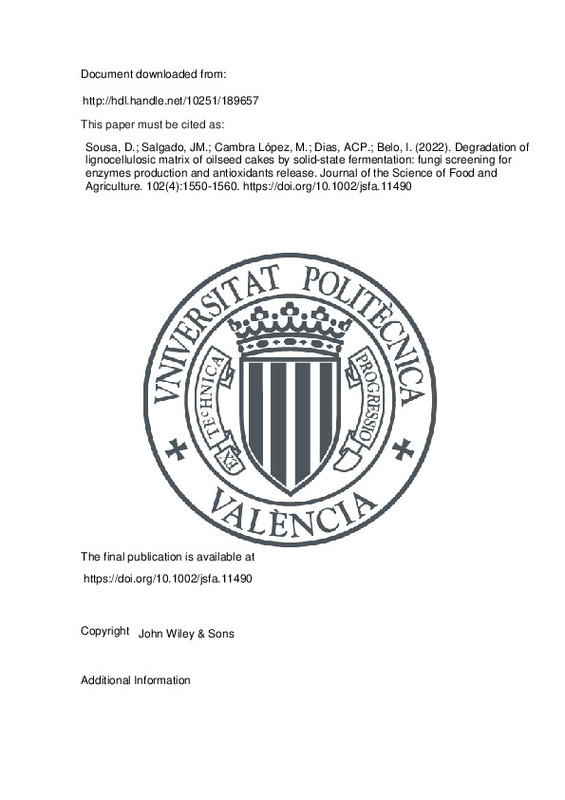JavaScript is disabled for your browser. Some features of this site may not work without it.
Buscar en RiuNet
Listar
Mi cuenta
Estadísticas
Ayuda RiuNet
Admin. UPV
Degradation of lignocellulosic matrix of oilseed cakes by solid-state fermentation: fungi screening for enzymes production and antioxidants release
Mostrar el registro sencillo del ítem
Ficheros en el ítem
| dc.contributor.author | Sousa, Daniel
|
es_ES |
| dc.contributor.author | Salgado, José M.
|
es_ES |
| dc.contributor.author | Cambra López, María
|
es_ES |
| dc.contributor.author | Dias, Alberto C. P.
|
es_ES |
| dc.contributor.author | Belo, Isabel
|
es_ES |
| dc.date.accessioned | 2022-11-12T19:02:39Z | |
| dc.date.available | 2022-11-12T19:02:39Z | |
| dc.date.issued | 2022-03-15 | es_ES |
| dc.identifier.issn | 0022-5142 | es_ES |
| dc.identifier.uri | http://hdl.handle.net/10251/189657 | |
| dc.description.abstract | [EN] BACKGROUND: Vegetable oils are yearly produced in large amounts generating solid by-products, the oilseed cake (OC). OCs are lignocellulosic materials that have been used for animal feed with some limitations due to high fibre content from the plant cell walls. Biotechnological processes can help to overcome these limitations and contribute to up-grading such by-products, enhancing their nutritional value as feed ingredients. RESULTS: All fungal species were able to decrease neutral detergent fibre and acid detergent fibre in all by-products. Additionally, relevant enzymes were produced by the three fungi studied resulting in an improved antioxidant capacity of all fermented OCs. Aspergillus niger led to the highest activity of cellulase (109 U g(-1)), xylanase (692 U g(-1)) and protease (157 U g(-1)) per dry OC matter and to the recovery of an extract rich in antioxidants, with the highest scavenging potential of free radicals and superoxide anion, iron chelation ability and reducing power. Rhyzopus oryzae produced the highest activity of beta-glucosidase (503 U g(-1)) and led to the highest liberation of total phenolic content (TPC). Principal components analysis showed that extracts with high antioxidant potential were obtained in solid-state fermentation (SSF) with high enzymatic activity. A positive correlation was established between the action of beta-glucosidase and TPC. CONCLUSION: Within the same bioprocess it was possible to improve the nutritional value of OCs and to obtain relevant bioactive compounds such as lignocellulosic enzymes and phenolic compounds with antioxidant potential, resulting in a significant improvement of already valuable by-products with commercial interest for animal feed. | es_ES |
| dc.description.sponsorship | The authors thank the Portuguese Foundation for Science and Technology (FCT) under the scope of the strategic funding of UIDB/BIO/04469/2020 and UIDB/04033/2020 units. Daniel Sousa was supported by the FCT (PD/BD/135328/2017), under the Doctoral Programme 'Agricultural Production Chains - from fork to farm' (PD/00122/2012). Jose Manuel Salgado was supported by grant CEB/N2020 - INV/01/2016 from Project 'BIOTECNORTE - Underpinning Biotechnology to foster the north of Portugal bioeconomy' (NORTE-01-0145-FEDER-000004). | es_ES |
| dc.language | Inglés | es_ES |
| dc.publisher | John Wiley & Sons | es_ES |
| dc.relation.ispartof | Journal of the Science of Food and Agriculture | es_ES |
| dc.rights | Reserva de todos los derechos | es_ES |
| dc.subject | Sunflower cake | es_ES |
| dc.subject | Rapeseed cake | es_ES |
| dc.subject | Soybean cake | es_ES |
| dc.subject | Lignocellulolytic enzymes | es_ES |
| dc.subject | Phenolic compounds | es_ES |
| dc.subject | Filamentous fungi | es_ES |
| dc.subject.classification | PRODUCCION ANIMAL | es_ES |
| dc.title | Degradation of lignocellulosic matrix of oilseed cakes by solid-state fermentation: fungi screening for enzymes production and antioxidants release | es_ES |
| dc.type | Artículo | es_ES |
| dc.identifier.doi | 10.1002/jsfa.11490 | es_ES |
| dc.relation.projectID | info:eu-repo/grantAgreement/FCT/6817 - DCRRNI ID/UIDB%2F04033%2F2020/PT | es_ES |
| dc.relation.projectID | info:eu-repo/grantAgreement/FCT//PD%2F00122%2F2012/ | es_ES |
| dc.relation.projectID | info:eu-repo/grantAgreement/FCT/6817 - DCRRNI ID/UIDB%2F04469%2F2020/PT | es_ES |
| dc.relation.projectID | info:eu-repo/grantAgreement/FEDER//CEB%2FN2020-INV%2F01%2F2016/ | es_ES |
| dc.relation.projectID | info:eu-repo/grantAgreement/FCT/POR_NORTE/PD%2FBD%2F135328%2F2017/PT | es_ES |
| dc.relation.projectID | info:eu-repo/grantAgreement/FEDER//NORTE-01-0145-FEDER-000004//BIOTECNORTE - Underpinning Biotechnology to foster the north of Portugal bioeconomy/ | es_ES |
| dc.rights.accessRights | Abierto | es_ES |
| dc.contributor.affiliation | Universitat Politècnica de València. Escuela Técnica Superior de Ingeniería Agronómica y del Medio Natural - Escola Tècnica Superior d'Enginyeria Agronòmica i del Medi Natural | es_ES |
| dc.description.bibliographicCitation | Sousa, D.; Salgado, JM.; Cambra López, M.; Dias, ACP.; Belo, I. (2022). Degradation of lignocellulosic matrix of oilseed cakes by solid-state fermentation: fungi screening for enzymes production and antioxidants release. Journal of the Science of Food and Agriculture. 102(4):1550-1560. https://doi.org/10.1002/jsfa.11490 | es_ES |
| dc.description.accrualMethod | S | es_ES |
| dc.relation.publisherversion | https://doi.org/10.1002/jsfa.11490 | es_ES |
| dc.description.upvformatpinicio | 1550 | es_ES |
| dc.description.upvformatpfin | 1560 | es_ES |
| dc.type.version | info:eu-repo/semantics/publishedVersion | es_ES |
| dc.description.volume | 102 | es_ES |
| dc.description.issue | 4 | es_ES |
| dc.identifier.pmid | 34402072 | es_ES |
| dc.relation.pasarela | S\446414 | es_ES |
| dc.contributor.funder | European Regional Development Fund | es_ES |
| dc.contributor.funder | Fundação para a Ciência e a Tecnologia, Portugal | es_ES |







![[Cerrado]](/themes/UPV/images/candado.png)

